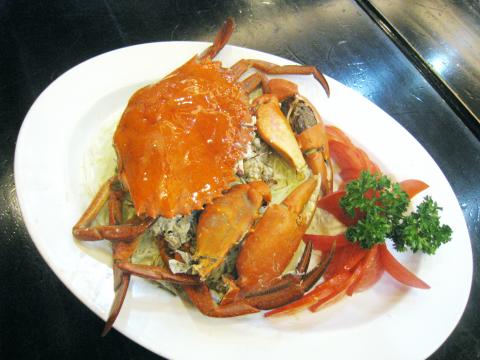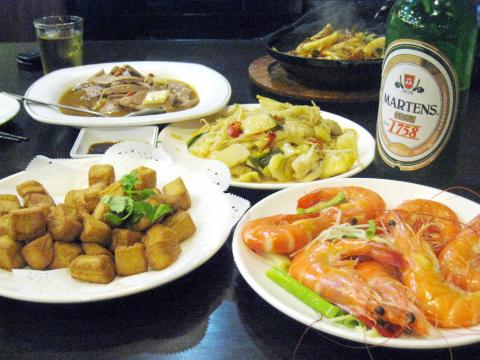A distinctive feature of Taiwan’s culinary landscape, the rechao (熱炒, literally “hot-fry”) joint is a perennial favorite with its fresh seafood, bargain prices and unpretentious atmosphere. I usually avoid such places, however, for several reasons, not least of which are the sometimes dirty surroundings, questionable hygiene standards, and inebriated men playing drinking games at a deafening volume while smoking like chimneys.
Located in the heart of Taipei’s East District (東區), Xanadu (鮮納肚) has restored my faith in rechao restaurants. Though boasting the typical trappings, including beer girls, it is an updated and much tidier version.
The interior is orderly and brightly lit; the utensils look clean. There is no fishy smell and smoking is not allowed until 9pm at the earliest, according to the restaurant’s very sociable proprietor.

Photo: Ho Yi, Taipei Times
Many of Xanadu’s dishes are made from offal. Popular dishes include sauteed pork liver (香煎豬肝, NT$100), which is delectably tender and doesn’t leave a metallic taste in the mouth like other restaurants’ versions do.
The extensive seafood menu includes sashimi platters of salmon, tuna, swordfish and squid that cost between NT$100 and NT$190 per dish.
The dragon balls (鹹酥龍珠, NT$150), or octopus mouths fried with scallion, chili and peanuts, come recommended, though they could be habit-forming.

Photo: Ho Yi, Taipei Times
Xanadu’s shuizhu pork slices (水煮肉片), boiled strips of pork and vegetables served with oil and spices, is a localized version of a Sichuan specialty. By localized, I mean the dish lacks the numbing quality of the Sichuan peppercorn. The dish comes in three sizes, with the smallest (NT$300) enough for a group of three.
The open seafood display offers options that are often not on the menu. Ask the waitstaff for recommendations, but treat the response with a healthy dose of skepticism. On a recent visit, my dining partners and I ordered a crab that cost NT$1,000 on the recommendation of our server. It turned out to be very disappointing.

Most heroes are remembered for the battles they fought. Taiwan’s Black Bat Squadron is remembered for flying into Chinese airspace 838 times between 1953 and 1967, and for the 148 men whose sacrifice bought the intelligence that kept Taiwan secure. Two-thirds of the squadron died carrying out missions most people wouldn’t learn about for another 40 years. The squadron lost 15 aircraft and 148 crew members over those 14 years, making it the deadliest unit in Taiwan’s military history by casualty rate. They flew at night, often at low altitudes, straight into some of the most heavily defended airspace in Asia.

Many people in Taiwan first learned about universal basic income (UBI) — the idea that the government should provide regular, no-strings-attached payments to each citizen — in 2019. While seeking the Democratic nomination for the 2020 US presidential election, Andrew Yang, a politician of Taiwanese descent, said that, if elected, he’d institute a UBI of US$1,000 per month to “get the economic boot off of people’s throats, allowing them to lift their heads up, breathe, and get excited for the future.” His campaign petered out, but the concept of UBI hasn’t gone away. Throughout the industrialized world, there are fears that

Like much in the world today, theater has experienced major disruptions over the six years since COVID-19. The pandemic, the war in Ukraine and social media have created a new normal of geopolitical and information uncertainty, and the performing arts are not immune to these effects. “Ten years ago people wanted to come to the theater to engage with important issues, but now the Internet allows them to engage with those issues powerfully and immediately,” said Faith Tan, programming director of the Esplanade in Singapore, speaking last week in Japan. “One reaction to unpredictability has been a renewed emphasis on

Taiwan’s democracy is at risk. Be very alarmed. This is not a drill. The current constitutional crisis progressed slowly, then suddenly. Political tensions, partisan hostility and emotions are all running high right when cool heads and calm negotiation are most needed. Oxford defines brinkmanship as: “The art or practice of pursuing a dangerous policy to the limits of safety before stopping, especially in politics.” It says the term comes from a quote from a 1956 Cold War interview with then-American Secretary of State John Foster Dulles, when he said: ‘The ability to get to the verge without getting into the war is